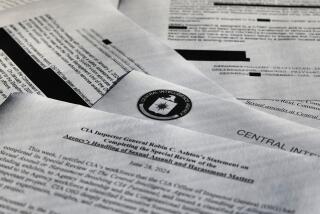Yurchenko Sent to Aid ‘Mole,’ Officials Fear
- Share via
WASHINGTON — U.S. experts studying the re-defection of Soviet KGB officer Vitaly Yurchenko are increasingly suspicious that he was a double agent dispatched to debunk another top defector’s warnings of a Soviet “mole” within the CIA, senior intelligence officials said Monday.
The intelligence officials described the suspicions--which arose from a new CIA analysis of the information Yurchenko provided before he returned to Moscow--as “not a clear-cut case,” and said CIA opinion on his reliability remains deeply split.
Pattern Suggested
But they said close study of independent intelligence data, combined with disclosures Yurchenko made during his three-month debriefing at a CIA safehouse in Virginia, suggest a “clear pattern” designed to steer U.S. experts away from a possible CIA mole.
Separate information leads those counterintelligence experts to conclude that if a mole exists, he probably occupies a “very senior level” within the CIA, said the officials, who spoke on condition that they not be identified.
The officials said they were making the new fears public because they hoped to prod the Administration, Congress and the CIA itself into a thorough review of the nation’s intelligence apparatus. They added that President Reagan last week secretly ordered an investigation of the CIA’s handling of all defectors.
Double Agent’s Tip
Word of a possible Soviet spy within the CIA came from another top Soviet agent, 23-year KGB veteran Oleg Gordievski, the intelligence officials said. Gordievski, the Soviet secret police’s top officer in Great Britain, had been working as a double agent for a decade when he quietly defected to the West in April, the officials said.
Britain kept the intelligence coup under wraps until five months later, when it expelled 25 Soviet nationals accused of spying. American officials have said Yurchenko sought asylum at the U.S. Embassy in Rome in August, four months after Gordievski’s secret jump to the West.
Yurchenko “told us there were no moles in the CIA,” one official said Monday. But the official added that “you can build a fairly solid case that Yurchenko was conceived, created and set in operation because of Gordievski.
“When you put it up to a suspicious optic, a lot of pieces fall into place. . . .,” he said. “But it’s a hell of a long way from proof.”
Yurchenko’s highly publicized flight Nov. 2 from a Georgetown cafe to the Soviet Embassy’s residential compound created a pre-summit propaganda coup for the Soviet Union and stirred long-simmering unrest over the way the CIA handles Eastern Bloc defectors.
Intelligence officials said the broader White House probe will be conducted separately from the agency’s own internal investigation of the Yurchenko debacle. It is aimed at uncovering U.S. mistakes in the way defectors are debriefed and introduced into Western society, in an effort to cut the substantial rate at which they return to their homelands.
Believed Sincere
Until now, most intelligence experts have assumed that Yurchenko was a sincere defector, wracked by depression and a broken love affair, who was grossly mishandled by his CIA custodians. No other explanation, they have said, would easily explain why a man touted by the CIA as the No. 2 Soviet spy in North America would place himself in the hands of the CIA’s most expert interviewers.
But the theory that Yurchenko was sent to protect a KGB agent within the U.S. government offers one plausible explanation for taking such a risk, officials said.
The CIA was wracked during most of the 1970s by accusations from within that a Soviet mole or moles had established a base in the agency’s highest ranks. The widely publicized allegations, by former CIA Deputy Director James Angleton and others, were never proven, but the internal finger-pointing is believed to have spurred the embittered departure of many of the agency’s most experienced spies.
The officials who spoke Monday said much undisclosed evidence points toward the existence of a CIA mole, but that some agency officials have been loath to set off another internal purge on the scale of that of the 1970s.
Not a Popular Subject
“Everybody wanted to believe Yurchenko was genuine because of the turmoil this subject has caused. . . . It was not a very popular subject for anyone,” one expert said.
The prevailing belief that Yurchenko was a sincere but disillusioned defector did not begin to crack until late last week, officials said, when counterintelligence analysts began piecing together a mosaic of his statements, Gordievski’s rumors and independent data.
As overseer of espionage in Britain, Gordievski normally would have known little about the highly compartmentalized Soviet spy network outside Britain and parts of Western Europe. He is reported to have told British intelligence only that a mole is somewhere “in the U.S. government,” and said his information came from “corridor talk.”
Early in his CIA debriefing, Yurchenko fingered a disgruntled former CIA employee, Edward Lee Howard, as the man who had revealed to Soviet agents the identity of one of the CIA’s most valued contacts in Moscow. That man, A. G. Tolkachev, was arrested in Moscow last June. Howard reportedly has fled to Moscow.
Yurchenko is said to have told his debriefers that no current CIA employees are Soviet double agents, an assertion that rises--or falls--on Yurchenko’s own credibility.
“It’s not a clear-cut case. A lot of Yurchenko’s debriefing reports have been analyzed,” one official said. “The prevailing sentiment to last weekend was that (Yurchenko) was genuine. . . . But more and more, the feeling is that he was sent.”
More to Read
Sign up for Essential California
The most important California stories and recommendations in your inbox every morning.
You may occasionally receive promotional content from the Los Angeles Times.













